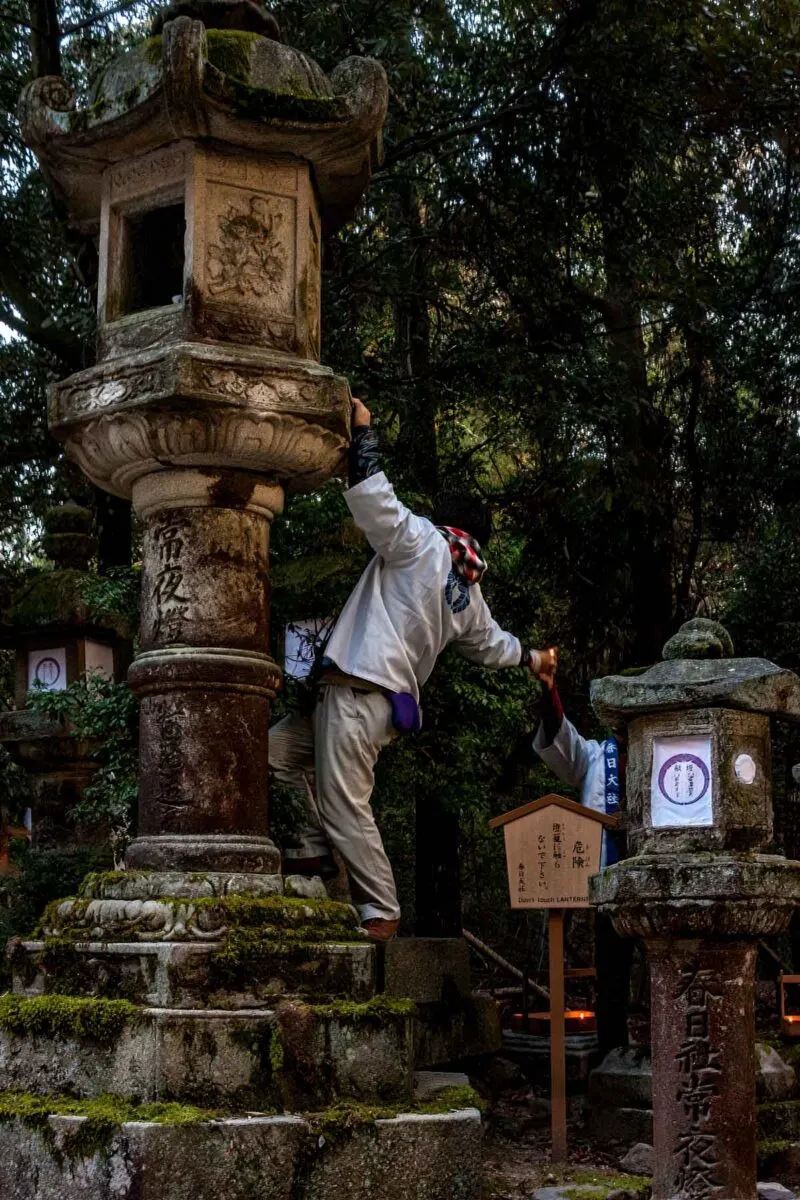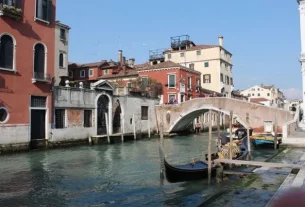Nara is an ideal destination to visit on a day trip from nearby cities such as Kyoto and Osaka. When you see our list of top things to do in Nara you might equally be tempted to stay for a few days and delve a little deeper into this heritage city that was once the capital of Japan.
With a population of around 400,000 people, Nara couldn’t be called a small city but its narrow lanes, wide open green spaces, a plethora of heritage sites and the odd deer that nudges you aside if you are blocking the path make it a refreshing change after the hustle and bustle of the major cities.

Table of Contents
Our self-guided walking tour of Nara
In this guide you’ll find our top things to do in Nara and a bit about why they make our highlights list, we’ve also put together this handy map to help you fit all the best bits into the time you have available without too much backtracking or wasted time.
It’s a Google map so you can save it to your phone and refer to it as you go. We like to have pocket wifi or a local SIM card when travelling in Japan to help out with the language barrier and for accessing maps but you should be able to save this one offline or even print a good enough version if you prefer to work that way.
Sometimes you can pick up an English paper map at the train station or the information centre but we’ve also been there when the basket is empty so it’s handy to have one of your own bookmarked and ready to go.
Our top 16 things to do in central Nara
1. Nara Park
One of the most striking things about the area is the enormous 502-hectare park running through central Nara at the foot of Mount Wakakusa. The park was established in 1880 making it one of the oldest in Japan and all this open green space plays a significant part in making a day trip to Nara feel very relaxed.

2. Get to know the local deer
Throughout Nara park and as you wander through the grounds of the many temples and shrines or even along the quieter shopping streets you can expect to see a large number of deer. There are said to be around 1300 of these Sika deer living in Nara Park and they are free to wander up the adjacent mountain and into the forest.
They are super cute and inquisitive but are still wild animals and not domesticated. In Japan, some consider them to be messengers of the gods and although they lost their official ‘sacred’ status in the mid-20th century they are still well protected as National Treasures.

Packs of ‘deer crackers’ are sold along the tourist routes in the city, use your own judgement about whether you want to feed the deer or not. There is no tradition or blessing associated with feeding them crackers and there is plenty of natural food available for them in the park. An occasional treat isn’t likely to be a problem but an excess of processed flour from an ever-increasing flow of tourists is taking a toll on their health.
With or without crackers you will see plenty of deer as you transit around between the attractions and through the park. This one snuck up to see what I was up to as I was watching his friends in the distance grazing quietly under the trees.
3. Sarusawa-Ike Pond
As you walk up Sanjo-dori from the JR station towards Nara Park you will come to the Sarusawa-Ike Pond. The pond has a long history having been dug in the year 749 within the grounds of Kōfuku-Ji temple. It’s not large but you can take a short stroll around it beneath the fluttering willow trees and sakura bloom in the spring season.

There is a Starbucks Coffee here that enjoys this view of the multi-tiered pagoda above the lake. Even if you don’t normally seek out Starbucks this one might be worth a stop, they have a strong local following in Japan with many of their stores making an effort to blend into the traditional landscape.
This one takes in the borrowed scenery of one of the most important temples in Nara but if you are a Starbucks fan you might also want to check out some of these ones not too far away in Kyoto city and Uji that are also quite different.
4. Kōfuku-Ji
This large temple complex is often one of the first stops on a trip to the city but if you are pushed for time, or arriving a bit later in the day you may choose to leave it until you are headed back to the station as the temple grounds don’t have closing hours.
The temple was founded in 669 in Kyoto. It was dismantled and moved to this site in Nara in 710 when it was the newly formed capital of Japan. Kōfuku-Ji was one of the 4 great temples of the Nara Period and one of 7 great temples in Nara during the Heian Period when Japan was ruled from Kyoto. At its most influential, Kōfuku Ji comprised over 150 buildings and while few of those remain today, the prestige of the temple is still evident.

The 5-storied pagoda is particularly beautiful but over the next few months you may find it is covered or partially covered as it is under renovation until 2023. A lot of its charm comes from the patina of natural wood, it was last restored in 1426 so I imagine it’s going to be quite an undertaking to protect it for the next 500+ years without losing that incredible character. When it’s not under renovation there are a few days a year when it is open to the public to see inside.

Another distinctive building that remains in this temple complex is the Octagonal Hall, this one is also occasionally opened to the public during the year to see the collection of treasures inside. We have been lucky enough to be in the city when this one was open and will usually pay the small entry fee when we come across these special openings.
The latest addition to the temple complex was completed and consecrated in 2018 and is a re-creation both in scale and architectural style of the earlier Central Golden Hall built between 710 and 714. The hall burned to the ground 7 times over the years, most recently in the early 1700’s so it’s a bit surreal walking through the middle of the complex now with this impressive building complete again and looking like it’s always been there but knowing it didn’t exist on our first couple of visits to Nara.
5. Kasuga-taisha
This shrine has an impressive history dating back to the Nara Period and is best known today for its lanterns. There are many rooms and walkways throughout the shrine grounds decorated with bronze lanterns then along the approach to the shrine as you wind your way through the park it is lined with stone lanterns of all sizes and shapes, most of them have been donated to the temple and many are very old.

Kasuga shrine is open from 6 am until 6 pm with a special night opening with lanterns lit both inside the shrine gates and throughout the park during festivals like Mantoro and Setsubun. There is a darkened room with lanterns during the rest of the year too but seeing the whole place lit up with the crowds and festival atmosphere is worth planning your trip around if you have the chance.
Another special time to visit this shrine is in early May when all the wisteria trees are in bloom with their weeping purple flowers celebrated as a symbol of the shrine.
6. Nandaimon, the great south gate to Todaiji
Japanese Buddhist temples face south so the Nandaimon, or the Great Southern Gate is the main entrance to Todai-ji. The huge wooden structure is over 25 metres high, the tallest temple gate in Japan and dates back to the 12th century. Even a big crowd is dwarfed by the scale.

At the top of this article is a photo of the Chu-mon or middle gate to Todai-ji. It doesn’t have the size or historical importance of Nandai-mon but it is also quite dramatic. As you enter or leave you can explore the shopping street beyond that offers some delicious snack food and look back at the view of Todai-ji across the lake.
7. Todaiji and the Great Buddha
Todai-ji is one of Japan’s most important historical temples. When it was built in 752 it was the head temple of all the provincial temples in Japan and held immense power through political and spiritual unity during the Nara Period.
The main hall is one of the largest wooden buildings in the world and houses a 15-metre bronze seated Buddha representing Vairocana with Boddhisatva statues positioned on either side. It seems bigger in person than it generally appears in photos because the ceiling beams and everything else in the great hall is also on a massive scale.

There are a few unique things to see and do while you are visiting the temple in addition to the usual activities like writing your wish or blessing on the decorative ema votive tablet, lighting incense, getting your fortune told or adding a stamp to your temple book (called goshuin). This is the only place that I know where you can take a shortcut to enlightenment in the next life by crawling through Buddha’s nostril or receive healing by reaching out to an 18th-century wooden carving of an Arhat (one of Buddha’s disciples).
8. Mount Wakakusa (Wakakusayama)
Mount Wakakusa or Wakakusayama, Yama means a mountain in Japanese, is a large grassed hillside in Nara city. Positioned behind Todai-ji and Kasuga Shrine it stands 350 metres tall and on the left-hand side, when looking at it from the city and temples, you will find a walking path.
It takes about 15 minutes to reach the plateau and another 25 minutes to reach the peak. If you just want the expansive views out over the city below you really don’t need to go past the plateau. The hillside is mostly grass so you have an unobstructed view from here, continuing on up the peak is optional for the bragging rights.

Many cherry trees are planted around the edge of the slope and add to the picturesque view in early April. The mountain is also the site of several festival events throughout the year.
9. Naramachi
Naramachi, or Nara town, is the old merchant district in Nara where you will still see the old traditional wooden houses and warehouses in the narrow lanes. Many have been restored into storefronts and there are a few museums too including Naramachi Karakuri Omochakan (the toy museum), Nara Kogeikan (an arts and craft museum) and Naramachi Shiryokan which displays many quirky artifacts that represent the history of the town.

The temple of Gangoji is in the Naramachi area along with the Harushika Sake Brewery and the Imanishike Shoin Residence that was historically the home of a senior official from Kōfuku-ji temple but now is a lovely space to enjoy green tea and traditional sweets inside or in the garden.
10. Isuien
Isuien (Isui-En) is a Japanese-style garden located between Kōfuku-ji and Todai-ji, about a 10-minute walk from each. It is open between 9.30 am and 4.30 pm with an entry fee of Y1200.
Key features of the gardens are the ponds fed by the Yoshikigawa river and the borrowed scenery of the Todai-ji Nandaimon Gate and Mount Wakakusayama beyond that. The gardens are comprised of a smaller front garden that dates back to the 17th century and a rear garden that was added later by a wealthy merchant.
The back garden features several tea houses and a small museum with a collection of the family’s curated collection of artworks from China and Korea. Like all Japanese gardens, Isuien is designed to be enjoyed in all seasons but it is especially pretty when autumn leaves are in full colour around the ponds.
11. Nara National Museum
Many temples in the area have treasure houses with impressive collections but the Nara National Museum is a large-scale museum spread across multiple halls and galleries with an extensive permanent collection and frequent visiting exhibitions. It began in 1889 as the Imperial Museum of Nara before opening to the public in 1895. Today it has an important role in restoring and preserving Buddhist art and archives in a way that makes them accessible to the public.

The museum is open from 9.30 am until 5 pm and entry is Y700 with some limited-time exhibits having additional entry fees. There are a few special opening days each year such as during Setsubun in February when entry to the main halls is free to the public.
12. Festivals and Events
While we regularly add local festivals and events to our Japan itinerary we particularly enjoy the ones hosted in smaller cities like Nara. If you are in town at the right time we would recommend visiting for Setsubun, Mantoro or the Wakakua Yamayako festival.
During Setsubun on the 3rd of February, events are happening all over town. Major events take place in the Kōfuku-Ji temple grounds with demons, performers and airborne soybeans but don’t overlook some of the smaller temples. Gangoji Temple is a personal favourite that is located a little off the main tourist flow in the older part of town so it’s got a lovely local feel.
You will also want to plan to stay for dinner and into the evening during Setsubun as the 3000 stone and bronze lanterns throughout Nara park and the shrine are all lit up which is a stunning sight. They still use candles so it’s a full-time and fairly athletic job for those clambering up the larger lanterns to keep them lit throughout the evening.

The Mantoro festival in August is your other opportunity to see the lanterns alight.
If your visit is earlier in the year the Wakakusa Yamayaki festival in January is centred around Mount Wakakusa behind the Todai-Ji temple. During the early evening ceremony the ceremony sets the hillside alight and while the controlled fires burn keep an eye on the sky for the fireworks display. While the ceremony takes place on the mountain the full effect is best observed from a distance.
13. Explore deeper with a local guide
While we like to explore independently and at our own pace we have taken several food tours with Magical Trip in various cities and they have all used local guides who know the area well and love to share their city with visitors. If you are interested you can read more about our tour with them in Gion (Kyoto) here.
The Magical Trip tour in Nara takes in the major sites and helps you get a feel for the area if your time is limited. Lunch is included at a location that has been selected for its use of locally grown produce which is something we like to support.
14. Nara Visitors Centre
Although we like to have our key highlights for the day sorted before we head out for the day, a tourist information centre can be really helpful for updates on any temporary closures, maps, and tourist deals and in the case of the Nara Vistors Centre, it does go above and beyond.
At the centre, they run cultural activities like teaching you how to fold an origami souvenir or you can attend an introductory green tea ceremony. They will write your name for you in Kanji, the Japanese alphabet if you ask or you can try your hand at calligraphy.
They are located adjacent to Nara Park which makes the Nara Visitors Centre Inn with either Western or Japanese style rooms, particularly good value. We haven’t stayed here yet but we have a couple of nights planned on our next visit and will add a full review after that.
15. Zuto Pyramid
In addition to being the name of both the city and the prefecture, the Nara period refers to an era in Japanese history. It was between 710 AD and 794 AD when Empress Genmai established the capital here, at the time called Heijo-Kyo.
Zuto is a pyramid reminiscent of those found in the Mayan empire and was built back in the Nara period predating many of the more famous landmarks in the city. While not massive in size, it’s a lesser-known artifact of the city and the age and history make it worth including if you have the time.
16. Try the local sake
Nara also has a long history with sake. It is believed to have originated here in the middle of the 14th century when Priests at Shōryaku-ji temple developed a technique to make it. While every sake brewery has its secret yeast blend, Shōryaku-ji remains the only temple with a license to make the “Bodaimoto” starter.
Sake from Nara, or Narazake, is still very highly regarded for its quality and you will find a few opportunities to try it while you are in town.
One option is to head to Harushika a brewery established in 1884. It’s located in a beautiful traditionally styled wooden building and is open from 9 am until 4.30 pm. Here you can try a tasting experience for Y500 with several different sakes from the company or if it is too early in the day for you, they also have a range of sweets made with their sake.
Another option is to include a sake bar such as Nihonshu to Otsumami Chuin at the end of the day. They are a tiny sake bar located in the Naramachi area and are open from 4 pm until 10.30 pm. You can check their Instagram profile linked in their photo below, their latest post shows that days featured sake bottles and opening hours.
How to get to Nara
There are two train stations close to the temples and attractions of Nara, the Nara Station operated by JR (Japan Rail) and the Kintetsu-Nara station. Both companies offer an excellent and reliable train service, the Kintetsu station is a little closer to the attractions but both are conveniently located. Choosing which is best for you will depend more on where you start from, whether you have a JR pass or other train pass to use for this trip and whether you prioritise price or time.
Best way to get to Nara from Kyoto
Both the Japan Rail and Kintetsu options depart and return to Kyoto Station.
With Kintetsu, you have the option of the limited express train which costs Y1160 and takes 34 minutes or the standard train which costs Y640 but you will need to transfer at a station along the way. The trains are frequent and the transfer is at smaller stations so it’s not difficult, it will take 50 minutes to an hour using this option.
With Japan Rail, you will take the Nara line, make sure you get the Rapid, it costs Y720 and takes 45 minutes direct. You can use your JR Pass for this if you have one.
Best way to get to Nara from Osaka
Being an Osaka-based company the options from the city to Kintetsu-Nara are very good. If you are staying in the Namba area, which is usually our preference, the rapid express is a direct train that costs Y570 and takes 37 minutes to get to Nara.
If you want to use JR because you have a JR pass or it’s more convenient for you, it will take 48 minutes with a transfer at Kyuhoji station.
Where to stay in Nara
Most first-time visitors will plan for a day trip to Nara and as you can see that is a great option. We often prefer to explore closer areas on a day trip to avoid changing accommodation too often as it can use up a lot more of the day than you intend.
However, if you have the available time in your itinerary you may want to consider stopping a night in Nara so you can spend another day and see the attractions at a slower pace, get a little further out to treasures like the Hōryū-ji temple or stay to enjoy a festival in the evening. Nara has some good options for overnight visitors too.
The Nara Visitors Centre Inn is where we plan to stay on our next visit, it’s an ideal central location for such an affordable option. It’s an 8-minute walk from the Kintetsu Station, 15-minutes from the JR Station and is near Kofuku-ji and Nara Park. They offer both Japanese and Western-style rooms and a lot of conveniences including a coin laundry, free WIFI and shared kitchen facilities if you want to make use of them.
If you are looking for something different, a ryokan, sole occupancy property, a major chain hotel, or something adjacent to the station you’ll find a range of Nara accommodation options to suit.
There is so much to love about Nara that we would place it very high on our list for anyone considering side trips from nearby cities like Kyoto and Osaka.
For those planning a visit please feel free to ask any questions we haven’t already covered in the comments section below. For those that have spent some time in Nara we’d be interested in your thoughts, is it one of your essential destinations on a Japan itinerary? What aspect of the city did you enjoy the most?



